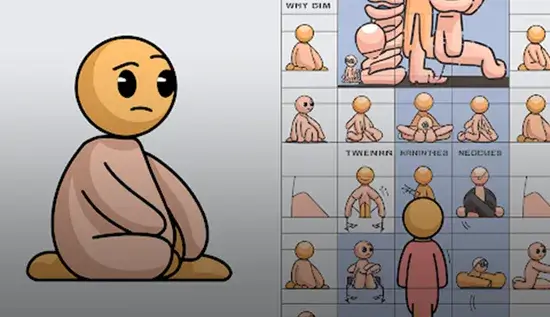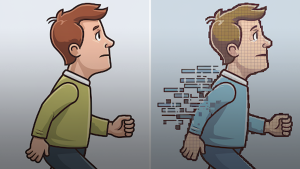Animation remains a very useful storytelling technique since it can bring characters, objects, and ideas to life using movement. The two most used forms of animation are tweening and Frame by animation. Understanding the fundamentals of smooth motion through tweening can help animators choose the right technique based on their animation style, project sizes, and production timelines.
We will examine how Frame-by-Frame Animation differs from Tweening and highlight their advantages and applicable areas, as well as the dos and don’ts of each method. You will know which technique fits your animation requirements best when we conclude.
🚀 Want to master tweening? Understand how tweening works in our tweening animation guide.
1. What is Tweening in Animation?
Tweening, which is short for in-betweening, is the technique of generating frames automatically between two keyframes so that the animation is smoother. Evolving from hand-drawn methods to digital tools, tweening has transformed the way animators work. Instead of sketching each and every frame by hand, which is draining and laborious, tweening lets animation software do the drawing for you.
Types of Tweening
✔ Motion Tweening – Moves objects from one position to another.
✔ Shape Tweening – Morphs one shape into another.
✔ Classic Tweening – A mix of keyframe and frame-by-frame animation.
✔ Skeletal Tweening – Uses a digital rig for 3D animation.
🎬 Common Uses of Tweening:
- 2D motion graphics
- Web animations
- UI/UX animations
- Explainer videos
- Video game animations
📌 Want to dive deeper? Explore different tweening techniques for smoother animation.
2. What is Frame-by-Frame Animation?
To put it simply, in frame-by-frame animation, also known as traditional animation, every frame needs to be completed individually, which makes the animation smoother. This approach to implementing the animation is a lot more demanding than the automated method of tweening.
Key Features of Frame-by-Frame Animation
✔ Manually drawn or adjusted frames for precise movement.
✔ Greater artistic control, ideal for complex or detailed animations.
✔ Time-consuming process, requiring more effort and skill.
✔ Used in hand-drawn animation, stop motion, and detailed character animation.
🎬 Common Uses of Frame-by-Frame Animation:
- Traditional 2D animation (Disney, Studio Ghibli, Anime)
- Hand-drawn character animation
- Stop-motion animation
- Animated short films and cartoons
3. Tweening vs Frame-by-Frame: Key Differences
| Feature | Tweening Animation | Frame-by-Frame Animation |
| Animation Speed | Faster – software generates in-between frames. | Slower – each frame is drawn manually. |
| Artistic Control | Limited – relies on keyframes and interpolation. | Full control – each frame is unique. |
| Fluidity | Smooth but sometimes mechanical-looking. | More organic, expressive, and natural. |
| Best Used For | UI/UX, explainer videos, motion graphics, games. | Traditional 2D animation, expressive character movements. |
| Workload | Less manual effort, more automation. | Labor-intensive, requiring frame-by-frame work. |
4. Pros & Cons of Tweening Animation
✅ Pros of Tweening:
- Time-efficient – Automates in-between frames, reducing workload.
- Consistent motion – Ensures smooth and uniform movement.
- Great for simple animations – Ideal for logos, UI animations, and presentations.
- File size optimization – Uses vector-based graphics, making animations lightweight.
❌ Cons of Tweening:
- Less expressive – Cannot match the organic feel of hand-drawn animation.
- Limited for character acting – Not ideal for subtle expressions and emotions.
- Can appear robotic – Requires manual adjustments for natural movement.
5. Pros & Cons of Frame-by-Frame Animation
✅ Pros of Frame-by-Frame Animation:
- More expressive – Best for detailed, natural-looking movements.
- No automation limitations – Every movement is fully customizable.
- Better for storytelling – Great for character animation, emotional expressions, and hand-drawn aesthetics.
❌ Cons of Frame-by-Frame Animation:
- Time-consuming – Requires drawing each frame individually.
- Higher costs – More labor-intensive, leading to longer production cycles.
- Larger file sizes – Since every frame is unique, projects require more storage and rendering power.
6. When to Use Tweening vs Frame-by-Frame Animation?
Use Tweening If:
✔ You need fast, efficient animations (e.g., UI animations, motion graphics).
✔ You want to animate simple movements (e.g., objects, text, backgrounds).
✔ Your project requires lower production costs and faster turnaround times.
💡 Example: Animated explainer videos, banner ads, website animations.
Use Frame-by-Frame Animation If:
✔ You need highly expressive, detailed character movement.
✔ Your project focuses on hand-drawn or traditional 2D animation.
✔ You’re creating films, cartoons, or anime-style animation.
💡 Example: Disney-style movies, anime, stop-motion animation.
7. How Modern Animation Combines Both Techniques
Many modern animation studios combine Tweening and Frame-by-Frame Animation for the best results.
🎬 Example 1: Disney & Pixar
- Uses frame-by-frame animation for detailed character expressions.
- Uses tweening for background elements and motion effects.
🎮 Example 2: Video Games
- Uses frame-by-frame animation for key character actions.
- Uses tweening for environmental animations and UI transitions.
By combining both methods, animators can create high-quality animated graphics quickly and effortlessly, making the ideal balance between productivity and creativity. Mastering smooth motion through effective tweening techniques ensures that animations remain fluid and visually appealing.
8. Choosing the Right Animation Method for Your Project
When deciding between tweening and frame-by-frame animation, consider the following:
🎯 Project Complexity – Is it a simple UI animation or a highly expressive character animation?
🎯 Time & Budget – Do you need a fast turnaround or a fully handcrafted animation?
🎯 Animation Style – Are you aiming for a realistic, detailed animation or a vector-based motion graphic?
FAQs
What is the main difference between tweening and frame-by-frame animation?
The main difference lies in how frames are generated:
✔ Tweening uses software-generated in-between frames to create smooth motion between keyframes.
✔ Frame-by-frame animation requires animators to manually draw each frame, making it more expressive but time-consuming.
📌 Example: For example, in a bouncing ball animation, the animator can simply artistically eliminate all the images showing the movement of the ball and only draw the initial and final phases of the bounce. The computer algorithm will do all the rest in between and generate the rest of the frames automatically. That is called tweening. The other alternative is frame-by-frame animation, which is much more tedious as the animator must sketch every single stage separately.
Is tweening better than frame-by-frame animation?
It depends on the project:
✅ Tweening, in this case, is more useful than frame-by-frame when it comes to automation, especially in motion graphics, UI animations, and other less complex movements.
✅ Frame-by-frame animation is best suited for character animation and storytelling that requires detailed manual control and movement.
🚀 Want to learn more? Explore different tweening techniques for smoother animation.
When should I use tweening instead of frame-by-frame animation?
Use tweening when:
✔ You need fast, smooth motion without extensive manual work.
✔ You’re creating UI animations, explainer videos, or motion graphics.
✔ Your project involves simple object movement, scaling, or shape morphing.
📌 Example: For instance, web designers will use it to animate a button hover effect, and advertisers will deploy it to create text slides for advertisements.
Can you combine tweening and frame-by-frame animation?
Yes! Many professional animations blend both techniques to balance efficiency and artistic control.
🎬 Example 1: Like Disney and Pixar movies, frame-by-frame animation is done for character movements while tweening is used for the background and effects of the movie.
🎮 Example 2: It is the same for video games. Character attacks or jumps are done frame-by-frame, but the tweening is utilized for the background and UI elements.
What software supports tweening animation?
Several animation tools have built-in tweening features, including:
✅ Adobe Animate – Best for motion and shape tweening in 2D animation.
✅ Toon Boom Harmony – Industry standard for TV and film animation.
✅ Blender & Maya – Used for 3D skeletal tweening and character rigging.
✅ Unity & Unreal Engine – Tweening is widely used for game animation and UI effects.
📌 Need expert guidance? Understand how tweening works in our tweening animation guide.
Why does frame-by-frame animation take longer?
Frame-by-frame animation is very tedious in nature as you have to draw every single frame, making it quite time-consuming. Unlike tweening, which automates movement, frame-by-frame needs:
✔ More drawings per second (usually 12-24 FPS).
✔ More attention to details in character movement.
✔ Longer rendering and production times.
🎬 Example: Frame-by-frame animation made hand-drawn animations like The Lion King (1994) take months to create. It is the same thing for the prettiest and smoothest animations when people’s faces are depicted in cartoons.
Does tweening always create smooth animation?
Not always! If tweening is overused without adjustments, it can create robotic or unnatural movement.
💡 To improve tweening animation:
✔ Use easing functions (ease-in, ease-out) for natural transitions.
✔ Add manual keyframes to refine motion.
✔ Combine with frame-by-frame techniques for better realism.
What industries use tweening vs frame-by-frame animation?
Both techniques are widely used in various industries:
🎬 Film & TV Animation – While frame-by-frame is still implemented for character animation, tweening or other types of animation are applied to the background and effects.
🎮 Gaming Industry – Frame by frame is best for meticulous movements, while UI animations and repetitive movements of the character are done using tweening.
📱 Web & Mobile Applications – Tweening is commonly used for smooth UI transitions, animated banners, and app interactions.
Is tweening animation suitable for beginners?
Yes! Tweening is one of the best ways to start learning animation because:
✔ It automates in-between frames, making animation faster.
✔ Most modern software has drag-and-drop tweening tools.
✔ It’s quite widespread in motion graphics, website animation, and mobile game development.
📌 Looking to level up your abilities? Try experimenting with different types of tweening to make animations seem more natural.
How can Prolific Studio help with professional animation?
At Prolific Studio, we specialize in:
🚀 2D & 3D Animation Services – For marketing, branding, and storytelling.
🎮 Game Animation & Character Rigging – Tweening, as well as frame animation, for games is for professionals.
📱 Motion Graphics & UI Animation – Helping companies make attractive animated content for websites and applications.
📌 Need professional animation services? Contact Prolific Studio today for a free consultation!
Final Thoughts: Tweening vs Frame-by-Frame Animation
As with all things custom-tailored, there are advantages to be gleaned from both frame-by-frame and tweening, depending on the creativity and the goal of the project at hand. Knowing how these techniques compare to other methods, like morphing, can help animators make more informed choices.
✔ Use Tweening for efficiency, automation, and simple movements.
✔ Use Frame-by-Frame Animation for expressive, hand-crafted animation.
✔ Use a combination for the best balance of time and creativity.
📌 Want to master tweening? Understand how tweening works in our tweening animation guide.
🚀 Need professional animation? Prolific Studio, one of the best animation studios in LA, is here to bring your vision to life! Contact us now. 🎬✨










